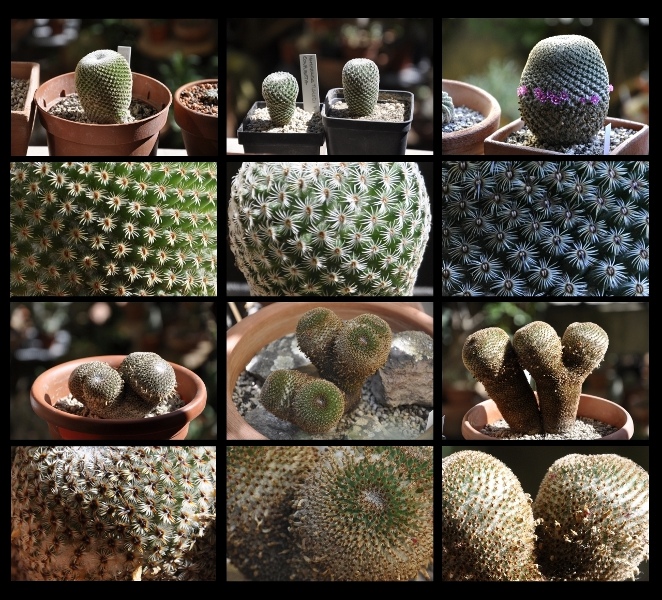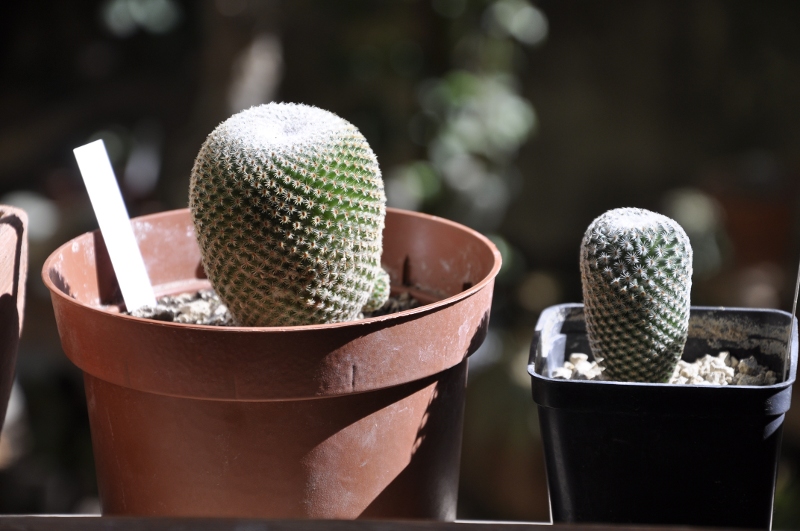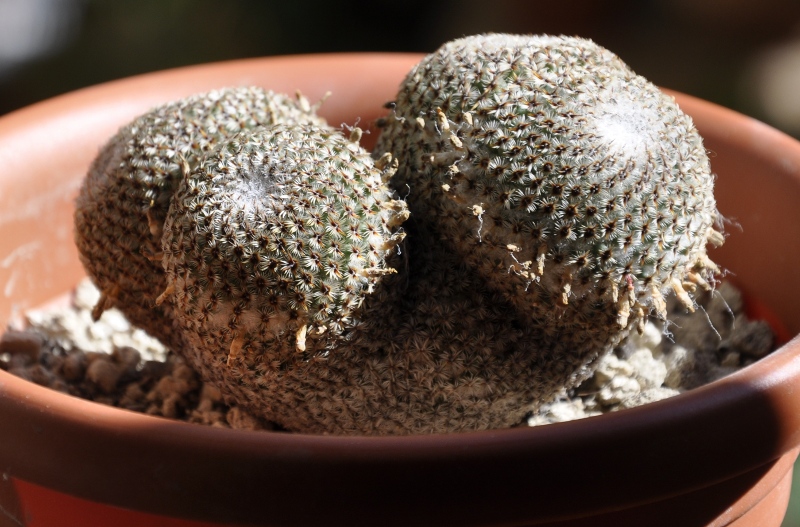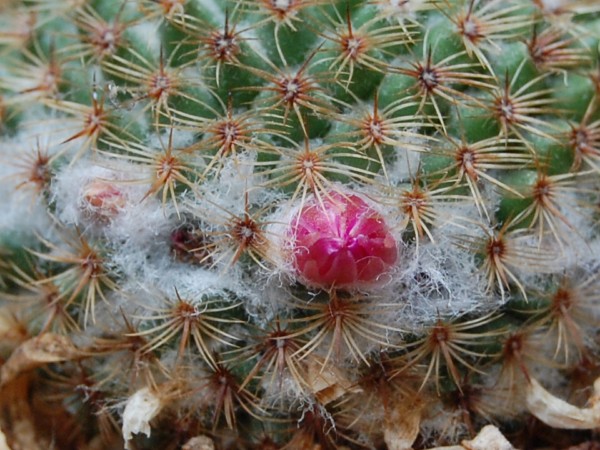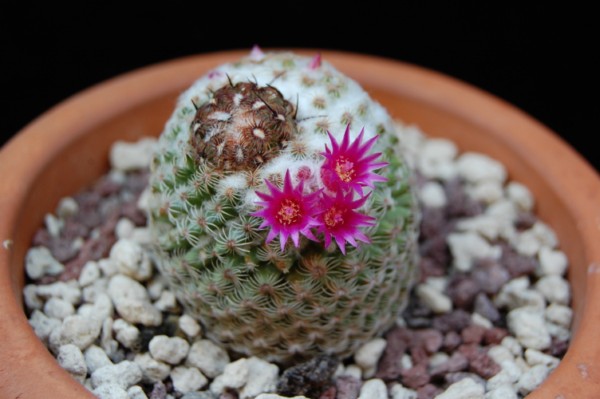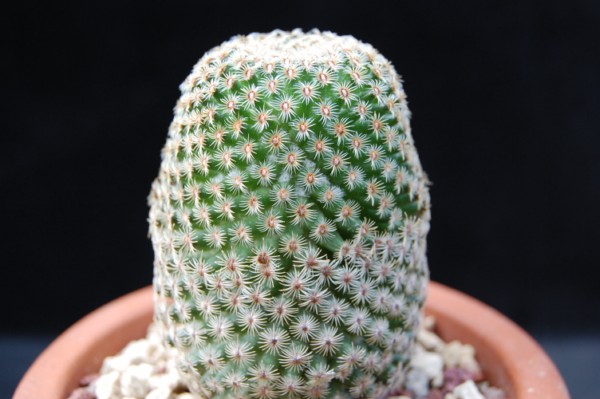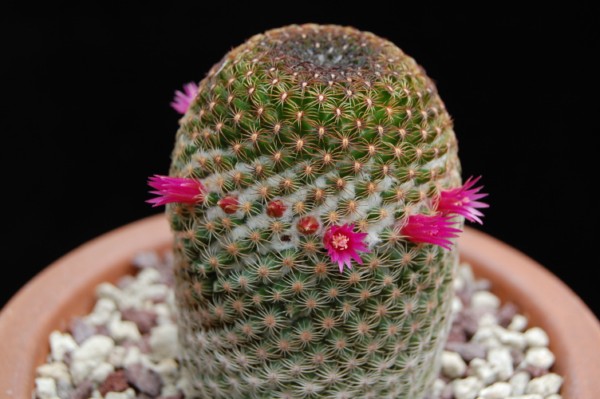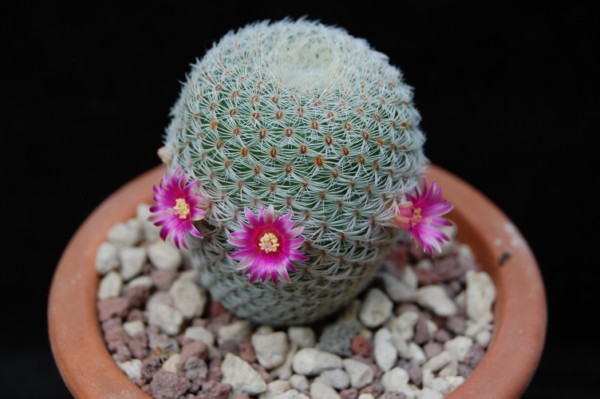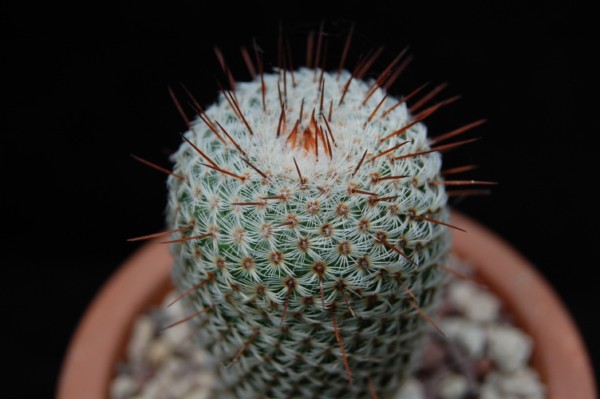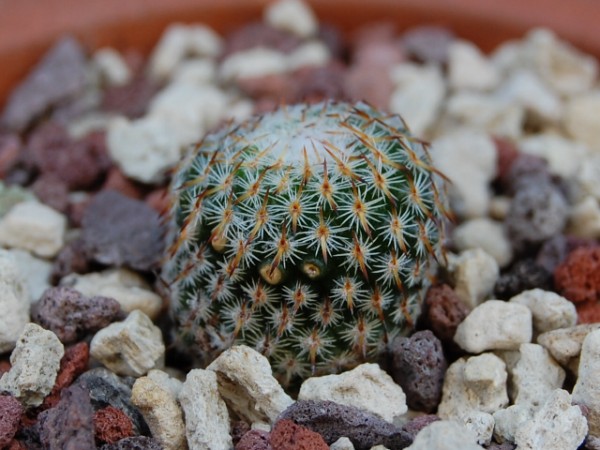Riporto le descrizioni delle due piante in questione ed alcune fotografie dalla mia collezione.
Spero abbiate materiale a sufficenza per esprimere giudizi sulle identità incerte.
Species Novae since The Mammillaria Handbook
by W F Maddams
No 85 Mammillaria huitzilopochtli
Original reference: D.R.Hunt, The Cactus and Succulent Journal of Great Britain 41, 106, 1979.
Body: Solitary at first, eventually branching dichotomously, globose at first but clavate-cylindrical
later, 13cm or more tall and 8-9cm. in diameter.
Roots: Fibrous.
Tubercles: Arranged in 13 and 21 spirals, small,
obtusely terete-conical, somewhat compressed
laterally, 6mm. long and 5mm. broad at the base, dark
green, sap watery.
Axils: Naked in the non-flowering areas, but with
dense whitish wool in the region where the flowers
appear.
Areoles: Elliptical, about 2mm. long and 1.5mm. wide,
minutely woolly at first but naked later.
Spines: Radial spines 15-30, 2.5-3.5mm. long, glassy,
white. Central spines 0-1 (rarely 2) in juvenile plants,
erect from the top edge of the areole, 4mm. long, finecircular,
very dark brown at first. In mature specimens
there is an additional porrect, subulate, dark brown to
black central spine, 1.5-2cm. long, but often reaching
5cm.
Flowers: Tubular-funnel shaped, 12-15mm. long and
7mm. in diameter (not widely expanded), mid to deep
carmine.
Fruit: Clavate-cylindrical, about 15mm. long, red, with
the dried perianth persisting.
Seeds: Very small, pyriform, with a short hilum, 1.4 x
0.75mm.
Type Locality: The Tomellin valley, in a gorge near
the confluence of the Rio Salado and the Rio
Quiotepec, Oaxaca, Mexico, growing on red
conglomerate rocks.
Distribution: Also from above Cuicatlan, Oaxaca.
Holotype: Lau 066, deposited at The Royal Botanic
Gardens Herbarium, Kew, U.K.
Comments: This species, which is well known to
succulent plant enthusiasts in general and not merely
to those whose interests focus on the genus
mammillaria, is named for the Aztec god of sun and war
No.91 Mammillaria tlalocii
Original reference: W. Reppenhagen, Die Gattung
Mammillaria, 120, 1987.
Body: Globose, later elongated, shaped like the bowl
of a pipe in habitat, rarely caespitose, with heads of
flowering size 50-200mm high and 50-70mm in
diameter. The apex is flattened, sunken and covered
with wool, from which small spines emerge.
Roots: Stringy/fibrous.
Tubercles: Densely packed, firm in texture, cylindrical,
5-6mm long and 2mm in diameter, without milky sap,
dark green.
Axils: Abundant white wool is present.
Areoles: Horizontally placed relative to the tubercle,
sunken, orbicular, 1mm wide, with much fluffy white
wool which gradually disappears.
Spines: Radial spines 16-22, 1-2mm long, the laterals
longest, straight or curved, smooth, with thickened
yellow base, spreading, somewhat ascending, glassy
white. Central spines 2-4, 1-2mm long, subulate, with
a thickened light brown base, mostly widely
spreading, glassy white with a fine brown tip.
Flowers: Appearing in May in a ring below the apex,
with few open at the same time, funnel form but
slightly swollen, 12-14mm long and 8-10mm wide.
Ovary turbinate, not noticeably differentiated, yellowish
white. Tube narrow and slightly distended, yellowish
white and rose above. Outer perianth segments
wedge-shaped to lanceolate, brownish rose with
lighter entire margins and an obtuse tip. Inner
perianth segments lanceolate, 5-6mm long and 1.5mm
wide, margins entire, with a small brown tip, rose with
an indistinct carmine mid-stripe. Filaments few, rising
2mm above the flower base, arising from the tube
wall, straight, white. Anthers large, light yellow. Style
7-8mm long, clearly over topping the stamens, white
and rose above. Stigma lobes 4-5, 1mm long
carmine-rose.
Fruit: Ripening six to ten months after flowering,
slender clavate, with a small dried perianth persisting,
8-15mm long, 2-3mm in diameter, carmine. Sterile
fruits are frequently produced.
Seeds: Light brown, roundish to reniform, 0.8mm long
and 0.7mm wide. Testa finely wrinkled. Hilum not
darkly bordered, small, elongate-ovoid-pointed, brown,
subbasal.
Type Locality: The Barranca Ixcatlan, Oaxaca, at an
altitude of 800 metres.
Distribution: Cited only from the type locality.
Holotype: Reppenhagen 901, collected on 27th
October 1974 and deposited at the Stadtischen
Sukkulentensammlung, Zurich, Switzerland.
Comments: Herr Reppenhagen places M.tlalocii in
what he terms the Crucigera group of the Series
Elegantes. He compares it specifically with
M.crucigera, and differentiates it on the following
basis:-
1. Its habit is almost always solitary; it occasionally
branches from the base, but never dichotomously,
and reaches a height of 200mm. By contrast
M.crucigera branches dichotomously and has heads
up to 60mm in height.
2. It has 16-22 radial spines and 2-4 glassy white
central spines whereas M.crucigera has 22-30 radial
spines and 3-6 brown or black central spines.
3. The flowers are 12-14mm long, in contrast to those
of M.crucigera which are 7-8mm in lengt
|
 Registrati
Registrati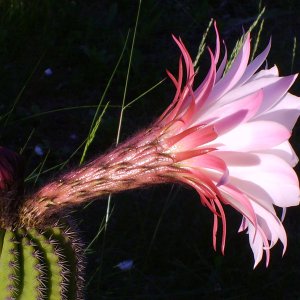
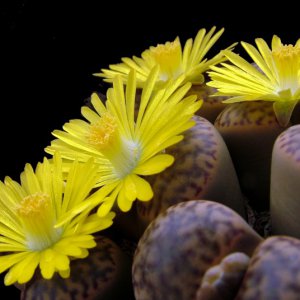
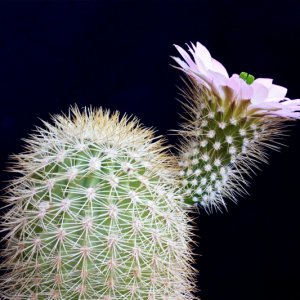
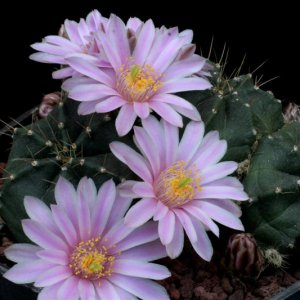








 e assomiglia di piu' alla n°5 e n°6 che sono due M. crucigera che non alla n°2.
e assomiglia di piu' alla n°5 e n°6 che sono due M. crucigera che non alla n°2.

